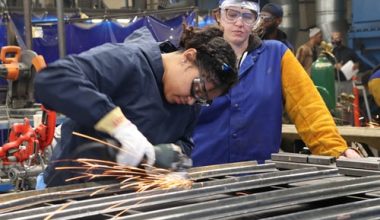A degree in aerospace or aeronautical engineering prepares students for engineering and aviation careers. More specifically, aeronautical engineering is one of the major branches of aerospace engineering; the other is astronautical. Regardless of their overlapping functions, they have their differences. So, in this aerospace vs. aeronautical engineering debate, you will learn their similarities and differences to help you determine which career path is best for you.
Both aerospace and aeronautical engineering covers aircraft design, from airplanes to missiles and space shuttles.
However, despite their similarities and overlapping functions, they differ uniquely. The significant difference is that while aerospace engineering covers aircraft and spacecraft design both within and outside the atmosphere, aeronautical engineering deals only with those within the atmosphere.
This article on aerospace engineering vs. aeronautical engineering has been written to give you a better understanding of these aviation engineers. Here, you get to what they do and the similarities and differences between an aerospace engineer and an aeronautical engineer.
You also get to know their job outlooks, salaries, the cost of becoming one, and the best aerospace and aeronautical engineering schools.
Here is a table of what to expect:
Before we go on, let’s get an overview of aerospace and aeronautical engineering.
Table of contents
- What is Aerospace Engineering?
- What Is Aeronautical Engineering?
- What Are The Similarities Between Aerospace and Aeronautical Engineering?
- Aerospace Engineering vs. Aeronautical Engineering: What Is The Difference Between Two?
- What are the Best Aerospace Engineering Schools?
- What Are The Best Schools For Aeronautical Engineers?
- Which is Best For Me, Between Becoming An Aerospace or Aeronautical Engineer?
- FAQs On Aerospace Engineering vs. Aeronautical Engineering: Salary, Similarities, Differences & Job Outlook
- Conclusion
- References
- AUTHOR’S RECOMMENDATION
What is Aerospace Engineering?
Aerospace engineering is an engineering field that covers the development of aircraft and spacecraft. It is one of the fastest-growing, dynamic disciplines that focuses on designing, maintaining, and improving all types of aircraft, from airplanes to missiles and space shuttles.
Basically, aerospace engineering is a branch of engineering that deals with the research, design, development, construction, testing, science, and technology of aircraft and spacecraft within and outside the earth’s atmosphere.
Who is an Aerospace Engineer?
An aerospace engineer primarily designs aircraft, spacecraft, satellites, and missiles within and outside the atmosphere. Aerospace engineers evaluate designs to see that the products meet engineering principles.
Aerospace engineers may also develop new technologies for aviation, defense systems, and spacecraft use.
What Is Aeronautical Engineering?
Aeronautics engineering is the science or art covering the study, design, and manufacturing of air-flight-capable machines. It also includes the techniques for operating aircraft and rockets within the atmosphere.
The engineering field deals with creating, designing, and maintaining travel machines, including airplanes, missiles, helicopters, and satellites.
Who is an Aeronautical Engineer?
An aeronautical engineer applies scientific, technological, and mathematical principles to research, design, develop, maintain, and test the performance of civil and military aircraft, including weapons, satellites, and even space vehicles within the atmosphere.
Want to become an Aeronautical Engineer? See these Top 10 Universities Offering Aeronautical Engineering In the World
You will notice some overlapping functions between aerospace and aeronautical engineering from the definitions above.
So, let’s compare their functions.
What Are The Similarities Between Aerospace and Aeronautical Engineering?
Despite the differences, aerospace and aeronautical engineering are similar in some ways.
Firstly, with a bachelor’s degree in aerospace engineering, one can pursue a career in both fields. Also, aerospace and aeronautical students usually take similar courses, like dynamics, propulsion, and fluid mechanics.
Secondly, aerospace and aeronautical programs generally take four to five years to complete and must be approved by the Accreditation Board for Engineering and Technology (ABET).
In addition, aerospace and aeronautical engineering graduates must take two examinations and accrue four years of work experience to become licensed professional engineers (PEs) in their state.
SEE ALSO: Desktop Vs. Laptop: What Do I Need As A College Student | Full Guide
They can, however, use the title of EIT (Engineer-in-Training) after passing the first NCEES Fundamentals of Engineering (FE) exam, which can be taken any time after graduation.
Then, EITs must also complete at least four years of on-the-job training, after which they take the PE exam to become professional aeronautical engineers.
Aerospace Engineering vs. Aeronautical Engineering: What Is The Difference Between Two?
The main difference between these two professions is that aeronautical engineering specializes in aerospace engineering.
Workers in aeronautical engineering often work exclusively with aircraft, while aerospace engineers may also work with weapons or spacecraft; and typically earn a higher salary than aeronautical engineers.
Apart from this significant difference, there are also other distinctions between an aerospace engineer and an aeronautical engineer.
Now, we are going to be looking at these differences in the following areas:
- Job/Duties
- Education
- Job Outlook
- Pay
- Cost
#1 Aerospace vs. Aeronautical Engineering – Job/Duties
Basically, the main duties of an aeronautical engineer overlap with that of an aerospace engineer across several aspects, except that the former only manufactures aircraft that operate within the earth’s atmosphere.
Now, let’s look at their functions independently.
What Do Aerospace Engineers Do?
Aerospace engineers primarily design aircraft, spacecraft, satellites, and missiles.
The duties of aerospace engineers include:
- Directing and coordinating aircraft and aerospace product design, manufacture, and testing.
- Assessing proposals for projects to determine if they are technically and financially feasible.
- Determining if proposed projects will result in safe operations that meet the defined goals.
- Evaluate designs to ensure the products meet engineering principles, customer requirements, and environmental regulations.
- Developing acceptance criteria for design methods, quality standards, sustainment after delivery, and completion dates.
- They ensure that projects meet quality standards.
- Inspecting malfunctioning or damaged products to identify sources of problems and possible solutions.
What Do Aeronautical Engineers Do?
Aeronautical engineers work with aircraft. Aeronautical engineers are involved primarily in designing aircraft and propulsion systems and in studying the aerodynamic performance of aircraft and construction materials.
They also work with the theory, technology, and practice of flight within the earth’s atmosphere.
Below are some major duties of an aeronautical engineer:
- Designing, developing, testing, and helping manufacture commercial and military aircraft, missiles, etc.
- Developing and creating unique technologies such as supersonic jets, helicopters, space shuttles, satellites, and rockets.
- Improving flight safety, fuel efficiency, speed, and weight.
- Reducing system costs.
- Using advancing technologies to meet client and customer needs
- Researching and developing design specifications
- Addressing the environmental impact of air travel and the materials/systems you will be designing.
- You will need to be able to resolve any issues that arise during the design, development, and testing process, including investigating any aircraft accidents and project management.
#2 Aerospace vs Aeronautical Engineering – Education
Basically, a bachelor’s degree in aerospace engineering would likely include both specializations. In contrast, a bachelor’s degree in aeronautical engineering would focus solely on those vehicles that fly within the earth’s atmosphere.
However, both options usually require students to take some similar courses, like dynamics, propulsion, and fluid mechanics.
Typical Coursework in an Aeronautical Engineering Program
Basically, students earning a degree in aeronautical engineering take classes such as:
- Thermodynamics
- Heat Transfer
- Aircraft Structures
- Flight Mechanics
- Aircraft Stability and Control
Typical Coursework in an Aerospace Engineering Program
In addition to the aeronautical engineering courses listed above, students earning a Bachelor of Science in Aerospace Engineering will also take astronautical courses like:
- Spacecraft Design
- Introduction to Astronautics
- Fundamentals of Jet Propulsion
- Spacecraft Dynamics
- Orbital Mechanics
SEE ALSO: Full Guide On How To Become A Marriage Counselor
#3 Aerospace vs. Aeronautical Engineering – Job Outlook
According to the US BLS, the employment of aerospace engineers is expected to increase by 2% from 2018 to 2028.
For this reason, growth in research and development activities will be tempered by a projected decline in the employment of aerospace engineers in the manufacturing industry.
As part of aerospace engineering, aeronautical engineering has the same projection and job outlook as it.
#4 Aerospace vs. Aeronautical Engineering – Pay/Salary
According to the US Bureau of Labor Statistics, the median annual wage for aerospace engineers is $116,500. Aerospace engineers earn $56.01 per hour.
On the other hand, on Glassdoor, the national average salary for an Aeronautical Engineer is $80,000 in the United States. However, on payscale, the average salary an aeronautical engineer earns is $78,442 annually.
#5 Aerospace vs. Aeronautical Engineering – Cost
The annual cost of tuition for a bachelor’s degree in aerospace or aeronautical engineering varies greatly depending on the kind of college or university you’ll be attending. That is, whether you’ll be attending it in-state or out-of-state.
What is the Cost of an Aerospace Engineering Program?
The tuition for an aerospace engineering program can go as low as a little over $8,000 in public institutions to over $45,000 in private universities for in-state students.
However, for out-of-state students, tuition ranges from about $27,000 for public schools to more than $45,000 for private institutions.
Notwithstanding, the tuition fee for an in-state aerospace engineering degree would run around $10,500 a year, while for someone studying out-of-state, the tuition average would be in the vicinity of $36,500.
What is the Cost of an Aeronautical Engineering Program?
At Georgia Tech, the cost for a 4-year bachelor could range between $180,000 (out of state, including housing) to $0 (if you qualify for the HOPE scholarship, work for housing to get a free room and get a side job to pay for food).
On the other hand, including all costs over four years, it will cost around $280,000 to attend MIT or as little as $200,000 to attend Purdue University or the University of Maryland. This cost includes several round trips from your country to the US college.
These costs are, however, before any financial aid. With financial assistance, they will pay lower than that.
In summary, if you come up with $200,000, you can get good astronautical engineering training in the USA and earn a bachelor’s degree.
Now you know the accrediting body, programs, and cost of becoming an aerospace or an aeronautical engineer, let’s look at some of their best schools.
What are the Best Aerospace Engineering Schools?
Here is a list of some schools that offer the best aerospace engineering programs in the USA.
- Massachusetts Institute of Technology
- Georgia Institute of Technology
- California Institute of Technology
- University of Michigan–Ann Arbor
- Purdue University–West Lafayette
- Stanford University
- University of Illinois–Urbana-Champaign
- University of Texas–Austin
- Texas A&M University–College Station
- University of Colorado–Boulder
- Embry-Riddle Aeronautical University
- University of Maryland–College Park
Get detailed information on the schools above. See the Best Aerospace Engineering Schools in the World
What Are The Best Schools For Aeronautical Engineers?
Various universities all over the world offer programs or specializations in aeronautical engineering. However, if you want to go to the USA, some schools offer programs for aspiring aeronautical engineers.
- California Institute of Technology
- Massachusetts Institute of Technology
- School of Aeronautics and Astronautics of Purdue University West Lafayette
- School of Aerospace Engineering of Georgia Institute of Technology
- Stanford University
- The University of Illinois at Urbana-Campaign
- The University of Texas at Austin
- University of Maryland College Park
- University of Michigan-Ann Arbor
- Virginia Tech
SEE ALSO: What Can I Get From Unpaid Internships In 2023?
Which is Best For Me, Between Becoming An Aerospace or Aeronautical Engineer?
Generally, these two engineering professionals are unique and distinct from each other. However, knowing what to pursue depends on your individual and career goals.
If you really want to concentrate on the manufacture and design of aircraft within the atmosphere, you can become an aeronautical engineer. However, if you design both aircraft and spacecraft within and outside the earth’s atmosphere, you can pursue a career as an aerospace engineer.
Furthermore, if you don’t mind doing any but want to do your job and earn more, you can compare the salaries of the two and go for the higher one.
You may also like to read Aerospace Engineering vs. Mechanical Engineering: Salary & Job Outlook.
FAQs On Aerospace Engineering vs. Aeronautical Engineering: Salary, Similarities, Differences & Job Outlook
Aerospace engineering is an engineering field that covers the development of aircraft and spacecraft.
Aeronautics engineering is the science or art which covers the study, design, and manufacturing of air-flight-capable machines. It also includes the techniques for operating aircraft and rockets within the atmosphere.
An aerospace engineer primarily designs aircraft, spacecraft, satellites, and missiles within and outside the atmosphere.
An aeronautical engineer applies scientific, technological, and mathematical principles to research, design, develop, maintain, and test the performance of civil and military aircraft, including weapons, satellites, and even space vehicles within the atmosphere.
Both aerospace and aeronautical programs generally take four to five years to complete and must be approved by the Accreditation Board for Engineering and Technology (ABET).
The main difference between these two professions is that aeronautical engineering specializes in aerospace engineering.
Conclusion
Both aerospace and aeronautical engineering covers aircraft design, from airplanes to missiles and space shuttles. However, although a degree in any of them will lead to a career in aviation and engineering, they differ.
The significant difference is that aeronautical engineering is a specialization within aerospace engineering. While the aerospace engineer focuses on aircraft and spacecraft within and outside the atmosphere, the aeronautical engineer focuses on those within.
Nevertheless, you want to pursue a career in this engineering field. Knowing your job and individual goals will help you decide what is better for you to become an aerospace or an aeronautical engineer.
This article on Aerospace vs. Aeronautical Engineering helps you make decisions.
Good Luck And Success!!!
References
- US BLS – Occupational Outlook Handbook of Aerospace Engineers
- Learn.org – What Is the Difference Between Aerospace and Aeronautical Engineering Degrees?
- Study – Difference Between Aerospace & Aeronautical Engineering
- CareerIgniter – How Much Does Aerospace Engineering School Cost?
- Quora – How much will it cost me to study aeronautical engineering?





